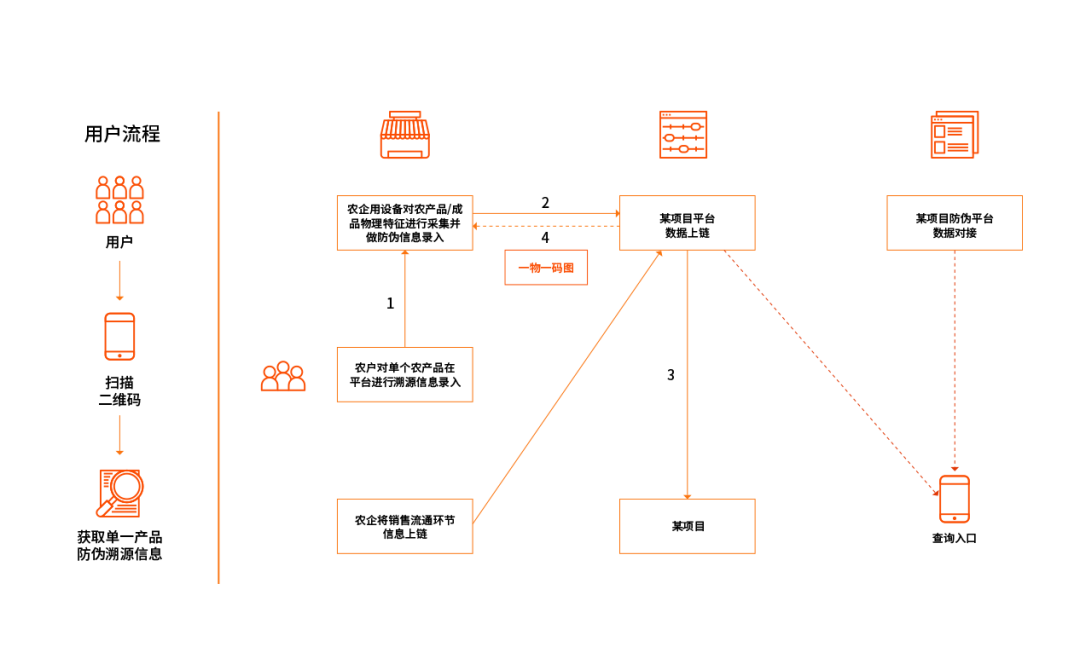Research | How does blockchain technology empower digital agriculture?
2020 is the year to achieve the goal of building a well-off society in an all-round way. China is a country with a large population and a traditional agricultural country. The "three rural" issue is one of the main constraints in China's modernization process, and it is also the focus and difficulty of building a well-off society in an all-round way.
On February 5, Xinhua News Agency was authorized to issue the "Central Document No. 2020" (the opinion of the State Council of the Communist Party of China on focusing on the key work in the "agriculture, rural areas, and farmers" area to ensure that a well-off society is achieved on schedule).
The "Opinions" determine that relying on existing resources to build agricultural and rural big data centers, accelerate the application of modern information technologies such as the Internet of Things, big data, blockchain, artificial intelligence, fifth-generation mobile communication networks, and smart weather in the agricultural field. Carry out national digital village trials.
The "Digital Agriculture and Rural Development Plan (2019-2025)" points out important measures such as building a basic data resource system, accelerating the digital transformation of production and operation, promoting the digital transformation of management services, strengthening innovation in key technical equipment, and strengthening the construction of major engineering facilities.
- Introduction | Blockchain Project Financing Tool: SAFT
- Blockchain Industry Weekly Report | Ministry of Industry and Information Technology: Guiding the Platform to Enhance New Technology Support Capabilities
- Smart contracts eliminate information asymmetry, build trust, and upend traditional insurance models
Under the goal of building a well-off society in an all-round way, strengthening peasants to benefit peasants, reform and innovation, and promoting agricultural modernization have become a major theme of successive agricultural-related documents issued.

Analysis of agricultural issues
- Decentralized agricultural land and difficult management
According to 2016 statistics, there are about 260 million rural households in China, and by 2050 there will still be 100 million rural households. However, at this stage, the production scale of farmers is small, land fragmentation is serious, and labor efficiency is low. Compared with the world's per capita, China's per capita arable land area is about 2 acres, which is 1/200 of the average American's area and 1/3 of the world average.
The phenomenon of "big industries, small farmers" will persist for a long time.
At the same time, in the management of agriculture and rural areas, there are many levels from the central to the local level, and many departments are involved. The overall coordination and management is further difficult.
- Informatization is not high and infrastructure is incomplete
The overall development of digital agriculture in rural areas lags behind and faces many challenges. The development foundation is weak, the data resources are scattered, the sky-ground integration data acquisition capability is weak, and the coverage rate is low. The construction of big data for the entire industrial chain of important agricultural products and the basic data resource system for agriculture and rural areas has just begun. Insufficient innovation capabilities, lagging behind in the development of key core technologies, lack of specialized sensors for agriculture, and poor adaptability of agricultural robots and intelligent agricultural machinery. Compared with medicine and other fields, digital research applications in agriculture and rural areas lag significantly behind. The level of digital governance in rural areas is low, and the gap is still large compared to urban areas. Digital industrialization is lagging behind, insufficient data integration and sharing, and insufficient development and utilization. The proportion of digital economy in agriculture is far lower than that of industry and service industries, which has become a prominent shortcoming in the construction of digital China.
Agricultural solutions
In order to solve the existing problems in the agricultural industry, Xita Technology proposes that it can start from the underlying infrastructure and gradually carry out agricultural blockchain transformation in the three directions of identity confirmation, asset confirmation, and financial services.
First, build a trusted agricultural digital identity system.
In solving agricultural problems, building a credible agricultural digital identity system is the basis for establishing trust between all parties. Specifically, each subject in agricultural production management should join the digital agriculture and rural digital system with a real and credible identity.
With trust, there is collaboration.
Digital identity is the link between the real world and the digital world, online and offline, on-chain and off-chain, and also the starting point. Only when the digital identity is trusted can real data and activities under this identity be mapped online and a corresponding system established.
The identity system can be regarded as the infrastructure of digital agriculture and rural areas. Most agricultural related data (land, operating income, debts, etc.) are associated with it. If the basic identity information is false or misappropriated, it is associated with it. There are problems with the authenticity of the data, and the value of the data has shrunk or even no value.
Only on the basis of clear real identity, can we effectively protect the data privacy of various subjects participating in digital agriculture and rural areas, and establish a data protection system based on privacy protection, so as to ensure the cooperation rights and interests of agricultural related subjects while taking into account efficiency.
Improving agricultural data governance
At present, from the perspective of the relationship of different technologies to data, the value of blockchain technology is to provide a credible foundation for realizing the value of data. In this way, the data can effectively generate the due value in the interaction of various application scenarios of digital agriculture and rural areas.
Simply put, data credibility determines its value, and it also affects the efficiency of collaborative behavior on data. The governance of data is to improve the credibility of the data and thus the efficiency of collaboration.
At the same time, it needs to be clear that supervision is also an integral part of data governance, and its importance is also related to data credibility.

In the system of digital agriculture and rural areas, the data can be simply divided into two categories based on the relationship with the agricultural management subject:
- Asset-based data: data on related entities such as land, agricultural products, and collective property; virtual asset data such as credit information
- Production and operation related data: soil, pesticide environment related data, supply chain related data
Among them, asset-based data needs to be certified by authoritative departments before it can be chained.
3. Establishing a collaborative network among various agricultural related entities
The digital rural agricultural system has nodes distributed throughout the country, and the cost of data falsification is high. Efficient collaboration is required in all links. It is an application scenario that is compatible with the blockchain.
The core value of the blockchain lies in improving the efficiency of social collaboration. Based on the trusted digital identity, combined with other data technologies, and using the blockchain technology data governance mechanism, a collaborative network based on trusted big data can be formed. In this way, the powers and responsibilities at all levels are clear, the supervision goes directly from the central government to the place, the direct information is achieved, the assets are transferred at multiple levels, and agricultural information systems are networked and coordinated.
Implementation of existing solutions
In order to achieve the strategic goal of a national demonstration base for an agricultural demonstration platform, Xita Technology will implement the project in three steps.
The first stage: build a blockchain + anti-counterfeiting traceability platform
After creating a "batch one code of a certain project" blockchain digital ID card, the project will store the product's digital identity information on the blockchain network through one object, one code and one picture, and all products will record physical characteristics through exclusive patented technology. One-to-one correspondence to digital tags or smart tags, so that every step of data collection, transaction, circulation, and calculation and analysis can be stored on the chain, and at the same time, ensure that the verified target is not subject to packaging counterfeiting, label counterfeiting, etc. Fake, so that the quality of the data has received unprecedented endorsement of strong trust, but also ensure the correctness of the data analysis results and the effect of data mining, to achieve the anti-counterfeiting traceability of the product market circulation process.

Users can use the traceability function of a certain project platform to control the entire process of farming or planting agricultural products, including environmental, processing, packaging and storage information at various stages, to form a unique blockchain digital ID for each batch of agricultural products.
The second stage: build blockchain + agricultural assets
In the second phase, the project will build a blockchain-based agricultural asset confirmation platform to form a better link value. Asset registration and value evaluation are performed at the same time, and the value of the on-chain assets is estimated.
Blockchain's characteristics such as traceability and non-tampering help to form a complete big data transaction information flow. Through data value assessment, it can make full use of on-chain data assets, maximize the effectiveness of assets, and meet the needs of value-added use of the transaction market. To speed up the circulation and realization of data assets.

The third stage: building blockchain + financial support
After completing the digital identity and data right layout, the trust network will eventually be built on the blockchain to allow existing trust data to circulate in the financial system, thereby generating value. The traditional agricultural financing guarantee system is commonly involved in the blockchain, and information flow, account flow, logistics (supply, sale, storage, and payment) are unified in one platform, which is conducive to improving risk control efficiency (pre-loan review, post-loan monitoring) Therefore, the risk of information asymmetry is reduced, the problem of information traceability and tamperability can be realized, the overall operating cost in the system is reduced, and the problem of financing difficulties for farmers, rural areas and farmers is solved.

To this end, the participants will jointly build a project trusting agricultural asset platform, and perform on-chain processing of agricultural assets to form effective digital assets and confirm their rights. Based on the confirmed digital assets, financial institutions and agricultural companies perform more efficient due diligence on the financing party and the submitted materials, and more effective review of risks. This shortens the financing cycle and provides support for agricultural financial services.
With the continuous exploration and deepening of the blockchain collaboration scene, Xita Technology will further focus on its own products, maximize the advantages of technological synergy, and jointly promote the rapid development of China's industrial blockchain ecosystem. By integrating upstream and downstream resources, it will continue to meet the needs of enterprises. User needs for blockchain technology.
We will continue to update Blocking; if you have any questions or suggestions, please contact us!
Was this article helpful?
93 out of 132 found this helpful
Related articles
- Is there any change in the cooperation between the self-built blockchain team of Zhongzhuang Construction and Yange Information?
- Gates and Li Ka-shing's blockchain business: one in the chain and one in the currency
- Let's talk about DAO from a human perspective
- Dialogue | The epidemic connects everyone more closely to the digital world blockchain makes it more credible
- You "don't need" DAO: What is the necessity of DAO?
- Industrial Blockchain Weekly Report | The first batch of virtual banks has been internally tested, and the ICT Institute launches a blockchain-based resumption platform
- Under the epidemic, how can blockchain make public welfare easier?






